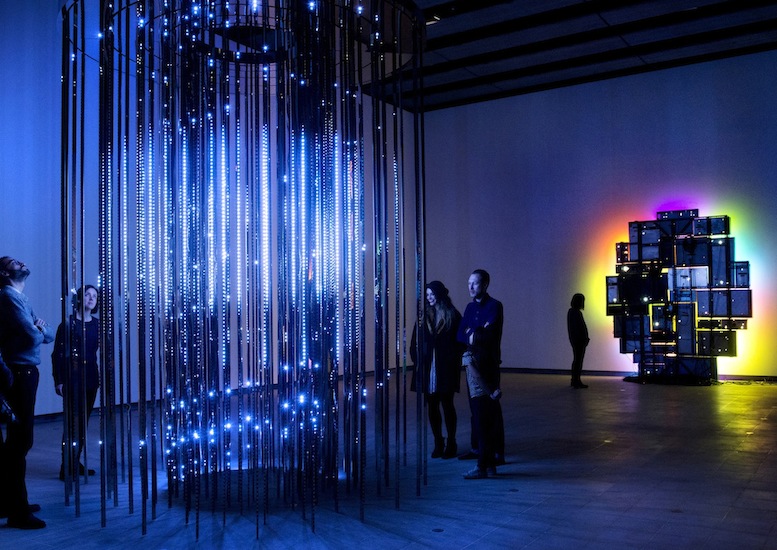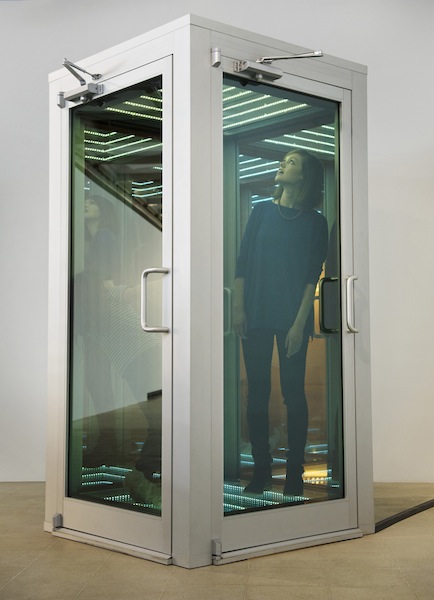Central to this thoughtful show is not really the use of light in art per se but how light appropriately serves a post-minimalist shift from the work of art to the environment itself. For the most part, the works here endeavour to shape the space around us or invoke a response on a physiological level.
The lower gallery’s main room is dominated by Cerith Wyn-Evans’s S=U=P=E=R=S=T=R=U=C=T=U=R=E ("Trace me back to some loud, shallow, chill, underlying motives overspil..."), 2010, made up of floor-to-ceiling columns of incandescent lights which “breathe” by slowly glowing bright and dimming, raising and lowering the light of the entire space. The effect is beautiful in combination with viewing Leo Villareal’s Cylinder II, 2012 (pictured below, courtesy of the artist and Gehring & Lopez), in which random patterns rise and cascade in hanging sci-fi-like LED lights. Unlike Villareal’s silent fountain of light, Wyn-Evans’ filaments hum, vibrate and heat up in their delicate tubes. There’s a transformational difference between seeing these lights from afar and close-up, the ethereal gives way to the material in a few steps.
 All light, of course, has its material basis, and the oscillation between material and immaterial is a running theme. This is perhaps most obviously sign-posted in the first room of the show by David Batchelor’s Magic Hour, 2004/7 (pictured above, far right), which exposes the arse-end of a stack of light boxes with power cables that hang loose and coil thickly on the floor. The boxes are haloed by the gaudy pinks and yellows it projects against the adjacent pristine wall. Batchelor’s use of light takes optically-focused modernist aesthetics as far as it can possibly go; as far as the other side of the mobius strip into the psychic junk – or poetry – of the viewers’ mental associations. It’s a fun place to be but perhaps the irony is a little too academic. Magic Hour thankfully feels like a good fit here given its physical bulk. It more than matches the challenge of the wide-open first room which too often overwhelms its contents.
All light, of course, has its material basis, and the oscillation between material and immaterial is a running theme. This is perhaps most obviously sign-posted in the first room of the show by David Batchelor’s Magic Hour, 2004/7 (pictured above, far right), which exposes the arse-end of a stack of light boxes with power cables that hang loose and coil thickly on the floor. The boxes are haloed by the gaudy pinks and yellows it projects against the adjacent pristine wall. Batchelor’s use of light takes optically-focused modernist aesthetics as far as it can possibly go; as far as the other side of the mobius strip into the psychic junk – or poetry – of the viewers’ mental associations. It’s a fun place to be but perhaps the irony is a little too academic. Magic Hour thankfully feels like a good fit here given its physical bulk. It more than matches the challenge of the wide-open first room which too often overwhelms its contents.
Physical also are the bodies that perceive light, and our senses are limited. “Visible reality is only a crumb of what’s really out there,” Conrad Shawcross writes. But while his Slow Arc Inside a Cube, 2011, spells this out with its shadow play (and you need to read an anecdote about the work to get his idea), Carlos Cruz-Diez successfully demonstrates it with his Chromosaturation, 2010 (main picture), an environment comprising of monochrome-lit rooms of red, green and blue which dazzles the eyes as you move through the spaces: you become acutely aware of the limitations of your senses; your very physicality, even.
 There is a conundrum at the heart of this show, striking a balancing act between mere perceptual play and serious aesthetic exploration. Many of the works teeter into the space of theatricality, such as Olafur Eliasson’s Model for a Timeless Garden, 2011, which uses the trickery of strobe-lighting to give the effect of crystallizing water in mid-air. It is, of course, fascinating to watch but I wonder where this work really takes us. On the lighter side we also have Ann Veronica Janssens’s Rose, 2007, an environment of pink light and fake mist, the entrance of which is topped by Philippe Parreno’s neon and Perspex Marquee, 2008. These nods to Pop’s influence are cursory and perhaps superfluous as they really jar with the interesting themes of the show. Those themes are of course embodied more or less in included works by two principal ground-breakers: Dan Flavin (material) and James Turrell (perception), but the omission of Bruce Nauman is surprising.
There is a conundrum at the heart of this show, striking a balancing act between mere perceptual play and serious aesthetic exploration. Many of the works teeter into the space of theatricality, such as Olafur Eliasson’s Model for a Timeless Garden, 2011, which uses the trickery of strobe-lighting to give the effect of crystallizing water in mid-air. It is, of course, fascinating to watch but I wonder where this work really takes us. On the lighter side we also have Ann Veronica Janssens’s Rose, 2007, an environment of pink light and fake mist, the entrance of which is topped by Philippe Parreno’s neon and Perspex Marquee, 2008. These nods to Pop’s influence are cursory and perhaps superfluous as they really jar with the interesting themes of the show. Those themes are of course embodied more or less in included works by two principal ground-breakers: Dan Flavin (material) and James Turrell (perception), but the omission of Bruce Nauman is surprising.
The curatorial coup here is anchoring these sensory investigations into the deep, dark waters of power. The inclusion of Ivan Navarro's Reality Box (Silver), 2010 (pictured above left), a phone box-like structure that feels like a torture chamber out of the pages of 1984, opens up questions about the punitive use of sensory disorientation, the deliberate unravelling of our senses to erode or extinguish our sense of self. Navarro’s experience of Pinochet’s Chile lingers in his unsettling work – we disappear to ourselves in his mise en abyme chamber while remaining fully visible to others.
Also tackling torture and power is Jenny Holzer’s Monument, 2008, a tall stack of LED displays which relays declassified statements from the war on terror like a sinister stock exchange ticker. Its column-like form gives its technology a monolithic weight and intensity which melds with the ticker’s authoritative power as pure and indifferent information. It strobes manically and scrolls a little too fast for us to keep track of the information that it darkly relays. These last two works cast a shadow over the other works like a twist in a novel, and this exhibition would not be as interesting without them. You suddenly feel unsure in your relationship not just with the environment around you, but the world itself.
- Light Show at the Hayward Gallery from 30 January to 28 April










![SEX MONEY RACE RELIGION [2016] by Gilbert and George. Installation shot of Gilbert & George 21ST CENTURY PICTURES Hayward Gallery](/sites/default/files/styles/thumbnail_125_x_125_/public/mastimages/Gilbert%20%26%20George_%2021ST%20CENTURY%20PICTURES.%20SEX%20MONEY%20RACE%20RELIGION%20%5B2016%5D.%20Photo_%20Mark%20Blower.%20Courtesy%20of%20the%20Gilbert%20%26%20George%20and%20the%20Hayward%20Gallery._0.jpg?itok=3oW-Y84i)




Add comment